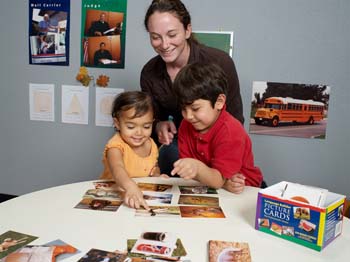 When very young children first begin to learn language skills, they learn new words by hearing the spoken word tied to the actual object (Richards & Goldfarb, 1986). For example, if parents repeat the word car every time they take their child to the car, the child will quickly learn that the word car represents the real car.
When very young children first begin to learn language skills, they learn new words by hearing the spoken word tied to the actual object (Richards & Goldfarb, 1986). For example, if parents repeat the word car every time they take their child to the car, the child will quickly learn that the word car represents the real car.
Learning new words is not limited to pairing a word with an actual object. As children get a little older, they can also learn new words when the word is paired with a picture representation of the object.
Studies show that nine-month-old children don’t yet see pictures as representations, or symbols, of an object. Most infants, instead, respond to pictures by hitting, rubbing, and grasping at the image. It is as if they are trying to pluck the object off of the page (Pierroutsakos & DeLoache, 2003).
However, in just a few more months, children start to understand that a picture is actually a symbol for a real object (Priessler & Carey, 2004). In fact, by 18 months, children are able to learn words by exploring pictures with adults, then generalizing these newly learned labels to the actual objects represented. In a study by Priessler and Carey (2004), 18-month old children were taught the word whisk using a picture of the whisk. Later, when asked by a teacher to choose the whisk from a group of other novel items, most children were able to correctly identify the real whisk.
As it is not always possible to introduce children to every actual object that you want them to learn, pictures provide a very effective, and practical, way to teach beginning language skills. When choosing autism education products and preschool education products, those with real pictures are a great way to go!
If you would like 20 free picture cards to use in your autism language program or any other program for teaching with pictures, click on this pretty blue button!

Want more information on teaching autism language with pictures? Check out our Autism and Language blog series:
Part 1: Encouraging Emerging Language and Receptive Vocabulary
Part 2: Building Vocabulary
Part 3: From Basic Vocabulary to Building Sentences
Part 4: Labeling and Requesting

